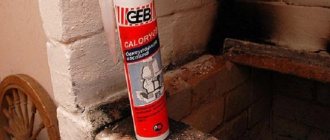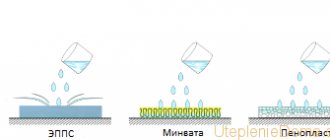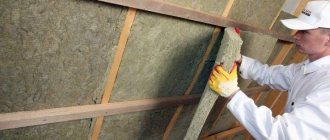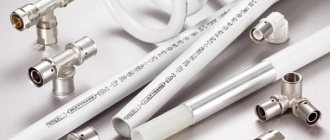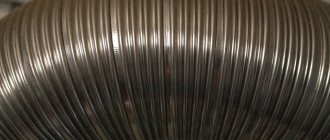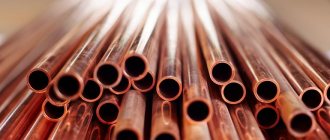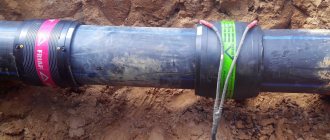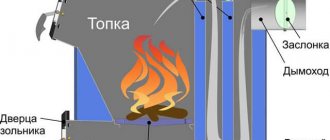Purpose and scope of application
The plastic tee is designed to create branches from the central pipeline. It must redirect the fluid flow in the required direction. Other purposes of the additional part:
- connecting household appliances;
- installation of shut-off valves and control mechanisms;
- adapter connection.
More often, PVC tees are installed on sewer drains and drainage channels.
Due to the characteristics of polyvinyl chloride, the tee is not suitable for connecting parts made of other materials. In addition to this, there is a pressure limitation. Do not use PVC piping elements for high pressure. They are used for the manufacture of non-pressure lines.
Methods for connecting to the water supply
Metal pipe
The easiest way is to connect the machine to a place where there is already a tee for a faucet, toilet or dishwasher. Having disconnected the hose of the device, another tee tap is installed in its place. The previously connected plumbing fixtures and the faucet for the washing machine are inserted into its outputs.
The second way is to use a “vampire” - a special device that is attached to the pipe with clamps. The “vampire” has a threaded branch similar to a tee. Connection technology in the next video tutorial.
When installing a water supply network, it is often necessary to change the direction of its laying or connect additional branches. A special fitting helps to do this - a water tee. Just like the pipes themselves, it can be made from different materials. Let's look at the features and purpose of this product.
This product has three ends with holes. Two of them, located on the same line, are connected to the main pipeline. A branch placed perpendicular to them serves to connect a branch of the water supply network.
The diameters most commonly used inside buildings are:
- 40 mm;
- 20 mm (three quarters inch);
- 15 mm (half inch).
Fittings can connect parts of a water supply system of the same or different diameters (for example, a riser and a branch to an apartment). Based on this, manufacturers produce products that differ in hole diameter. According to this parameter, there are the following types of tees for water supply:
- equal-bore analogues: they have the same cross-section on all sides;
- transition elements have two ends of identical diameter and one hole of a different size;
- for combined parts, the ends may differ in cross-section (they also have one external thread and two internal threads).
Depending on the connection method, there are the following types of products:
- elements with external thread;
- parts with internal thread;
- fittings with union nut;
- products with welded joints;
- analogues with a combined connection.
Metal fittings
Metal tees are most often used. They are used not only for domestic water supply networks, but also for industrial ones.
Most often, metal fittings are produced by casting; for this purpose the following is used:
- copper;
- brass;
- bronze;
- steel: stainless, galvanized, nickel-plated, carbon, alloyed;
- cast iron.
Steel products can be threaded or welded.
In addition to casting, the following methods are used in the manufacture of metal fittings:
- hot stamping;
- welding of workpieces;
- hydraulic stamping.
Seamless or electric-welded pipes are used as blanks. In the production of products, cutting (cutting blanks) and cross-cutting machines are used.
Production takes place in two stages. First, a piece of metal of specified dimensions is prepared on a cutting unit. Then a fitting is made from it using one of the above methods.
The most commonly used method is stamping. The blanks are made from solid sheets, so this method is the most economical. In industrial production, fittings are manufactured using the hot stamping method, since it is advantageous when producing large quantities of fittings. The hydraulic stamping method is mainly used in small industries.
Important! The main advantage of metal tees is their high level of strength. They can withstand high pressure in the water supply network.
You should not skimp on the quality of fittings. The reliability and service life of the water supply depends on this. When selecting fittings, you should take into account what external and internal loads (network pressure) will affect the water supply system. Their duration must also be taken into account.
Tees for plastic and metal-plastic pipes
A separate category should include a tee for water supply made of plastic or metal-plastic. According to the connection method, tees are divided into:
- threaded fittings;
- welded (a special soldering iron is used) elements;
- collet (crimp) elements;
- segment parts;
- press sleeve fittings;
- combined analogues.
According to the material of manufacture, fittings for plastic pipes can be:
- metal;
- plastic;
- composite.
Plastic tees, including collet and welded ones, are made from polypropylene, polyethylene and polyvinyl chloride.
Important! Their main advantage is their inertness to the transported resource and the environment. Thanks to this, plastic tees can be used for up to 50 years.
Composite fittings are made from HDPE (low-density polyethylene), inside which steel, brass or bronze bushings are located. Such fittings are most often used to interconnect plastic and metal pipelines. On the side intended for the metal network, the fittings are equipped with a corresponding threaded bushing. The end connected to a plastic pipe, either welded or crimped. This allows you to connect control and measuring devices, for example, pressure gauges, to the network.
Fittings with tap
Modern homes are often equipped with dishwashers and washing machines. To connect them, you need a water tee with a tap.
This fitting most often consists of:
- nickel-plated brass body;
- ball valve;
- handles, in most cases they are plastic;
- rubber or Teflon sealing rings;
- rod;
- union nut.
A household tee is used to connect the washing machine to the water supply, as well as other household appliances that consume water.
The element is connected using a clamping nut, using the fitting method. In this case, the tap can be installed in a position suitable for the user. Specifications:
- the fittings can withstand the temperature of the transported resource from −10 to +95º;
- the element is intended for use in water supply networks with a pressure of no more than 8 bar;
- the angle of rotation of the faucet handle is 90º;
- element weight approximately 100 g;
- the cross-section of the holes can be 15 or 20 mm;
- threaded connections can be external or internal;
- Product service life is 4000 cycles.
Plumbing tees can be made from different materials and are designed for different types of pipes. They can also be connected to the pipeline in a variety of ways. Thanks to this, it is possible to select parts for a network of any configuration and design.
Quite often, the owners of their houses and apartments, when supplying water independently, are faced with the question of how best to distribute water throughout the apartment. There are two most common pipe routing methods.
- Wiring on tees - economical
- - practical
If someone decides to replace old pipes with new ones because the lights are already clogged and water is not flowing well, then the new pipes are also assembled on tees. It's easier and cheaper this way. Although, when overhauling a bathroom, some install collector wiring.
Types and differences
Tees made from polyvinyl chloride are divided into two groups depending on the direction of the branch:
- Inclined. The branch is located at an angle of 45, 30 degrees to the main pipe.
- Straight designs. The branch is located at an angle of 90 degrees.
Depending on their purpose, there are several other types of parts that differ in design:
- equilateral parts for connecting individual elements of the same diameter;
- adapters for joining pipes of different diameters;
- tees for threaded hoses.
In problem areas of the pipeline, inspection parts are often installed, which have a separate outlet with a plug. It opens to clear the line.
Types of tees
Installation and types of polypropylene tees
Fittings from this material are made using injection molding technology, resulting in high-quality products. These tees come in the following types:
- Transitional - models that are used to connect plastic pipes with different diameters.
- With union nut.
- Combined polypropylene tee fittings are varieties designed for connecting plastic and metal pipes. Such models are produced in two variations: with internal thread and external thread.
- Equal tees are used to connect pipes with the same diameter.
The considered polymer products must be mounted using a special soldering iron, which is sold complete with a set of replaceable nozzles for a certain diameter. The process itself includes the following simple work:
- Prepare the pipes in this way: remove the foil layer with a trimmer and chamfer with a calibrator.
- Heat the tee evenly with a soldering iron, the operating temperature of which should be 260 °C. Then repeat the same steps with the pipe, but using a nozzle of a different size.
- Carefully connect the heated parts and wait until the plastic hardens completely.
However, there are other ways to secure pipes into a tee. This includes options such as the crimp method (requiring a special wrench), cold welding, and the use of push fittings.
Selection principles
When purchasing a fitting for connecting household appliances, shut-off valves or additional branches to a common pipeline, you need:
- check the presence of an o-ring in the kit;
- compare the cross-section of the pipes so that the fitting fits them exactly;
- the material of the connecting part must match the elements being connected;
- buy a plug if it is not included in the kit if the connection will not be used.
It is necessary to determine in advance at what angle the branch will be made in order to select a fitting of the desired configuration.
Advantages and disadvantages
Advantages of PVC tees:
- low price;
- ease of installation;
- versatility - you can connect household appliances, additional pipes, shut-off valves, and flow control mechanisms.
Flaws:
- Low resistance to temperature changes.
- Insufficient resistance to water hammer and pressure. Therefore, such fittings are not suitable for installation on pipelines operating under high pressure.
When heated, polyvinyl chloride releases harmful substances, which is why it cannot be used to assemble drinking water supply systems. PVC fittings cannot be used to connect parts made of different materials.
Manufacturers and prices
Manufacturers of PVC fittings:
- "Hemkor";
- "Era";
- "NASHORN";
- Rehau;
- Ostendorf;
- FIP SPA;
- Coraplax.
The average price is 150 rubles. It depends on the diameter, size, angle. The price for fittings with the largest cross-section reaches 1000 rubles.
PVC fittings
Application of steel tees
Tees made of steel are used: on main and supply pipelines, in heat and water supply enterprises, as well as in oil, gas and chemical industries. Steel tees can be processed through a variety of processes, coated with a variety of coatings, or simply made from specialized grades of steel, so steel tees can be used in virtually any work environment and exposed to virtually any environment. Such tees provide a reliable connection of pipes, have a low coefficient of thermal expansion and have high gas tightness. Tees made from carbon and low-alloy steel grades are used in non-aggressive environments, and for environments with increased aggressiveness, tees made from alloyed, high-alloy, and stainless steel grades are used (stainless steel tees).

